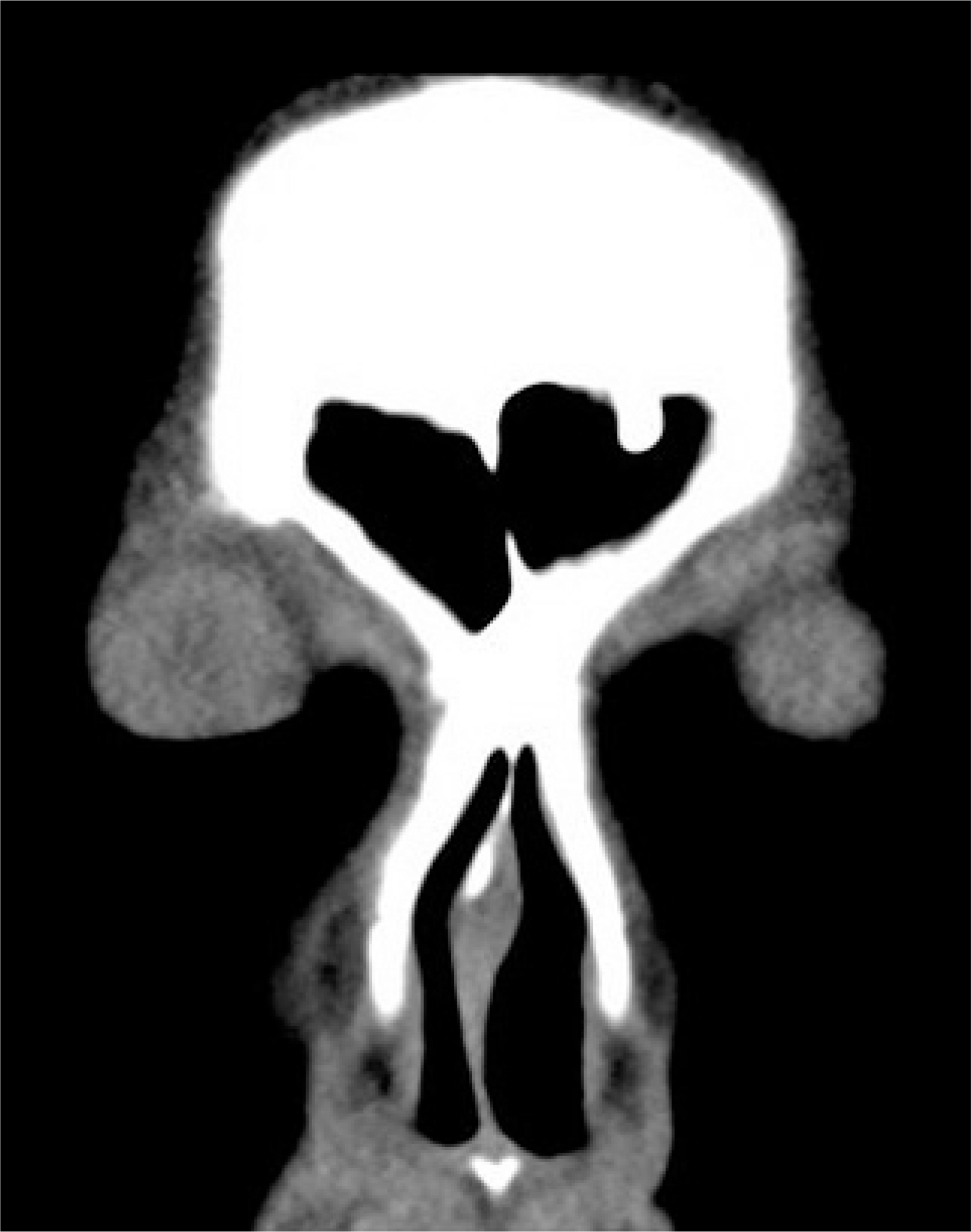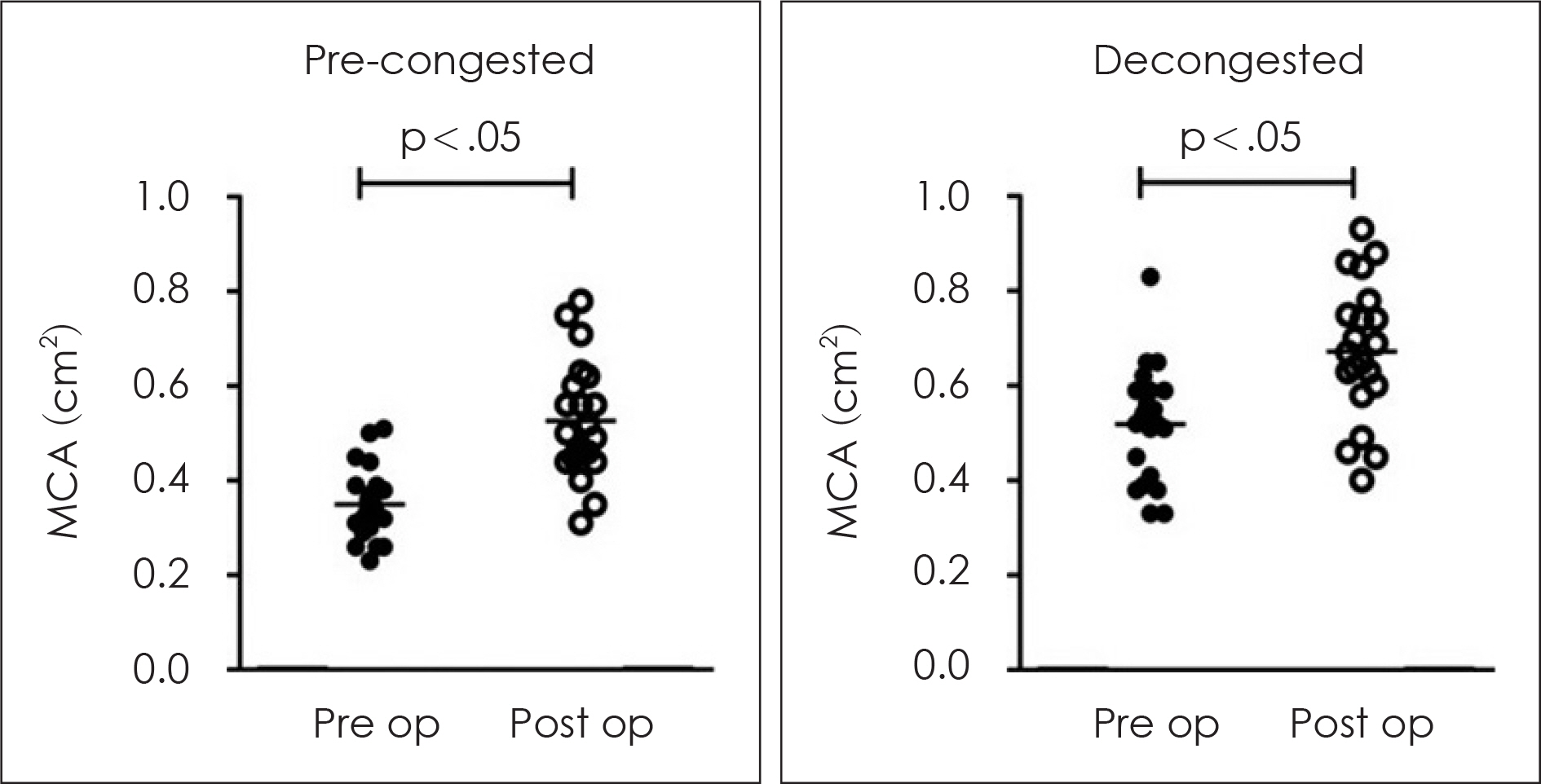J Rhinol.
2016 Nov;23(2):85-90. 10.18787/jr.2016.23.2.85.
Should the High Septal Deviation be Corrected to Improve Nasal Obstruction During Septal Surgery?
- Affiliations
-
- 1Department of Otorhinolaryngology, Seoul National University College of Medicine, Seoul, Korea. hyunjerry@snu.ac.kr
- 2Department of Otorhinolaryngology & Head and Neck Surgery, College of Medicine, Chung-Ang University, Seoul, Korea.
- KMID: 2361320
- DOI: http://doi.org/10.18787/jr.2016.23.2.85
Abstract
- BACKGROUND AND OBJECTIVES
High dorsal deflection of the nasal septum around cartilage or the perpendicular plate is technically difficult to correct. The objective of this study was to assess whether correction of high septal deviation during septoplasty is necessary to improve nasal airflow. PATIENTS AND SURGICAL METHOD: Twenty-one patients with high septal deviation around the septal cartilage or the perpendicular plate were included in this study. In order to improve nasal obstruction, septoturbinoplasty was performed, but high septal deviation was not corrected. Subjective and objective improvements were evaluated using the visual analogue scale and acoustic rhinometry 1 month before and 3 months after surgery.
RESULTS
After correction of nasal septum deviation except high septal deviation and reduction of turbinate mucosal volume, postoperative nasal volume and minimum cross-sectional area were significantly increased. Subjective symptom scales for nasal obstruction, rhinorrhea, sneezing, and posterior nasal drip were considerably improved after limited septoturbinoplasty in patients who still had high dorsal deflection of the nasal septum.
CONCLUSION
Our findings suggest that limited septoturbinoplasty without excessive resection of high dorsal deflection of the nasal septum can improve nasal airflow and reduce subjective symptoms, including nasal obstruction.
MeSH Terms
Figure
Cited by 1 articles
-
Clinical Outcome Study after External Approach Septoplasty
Do Yoon Jeong, Yoon Sik Park, Ji Yun Choi
Korean J Otorhinolaryngol-Head Neck Surg. 2021;64(2):86-92. doi: 10.3342/kjorl-hns.2020.00549.
Reference
-
References
1). Min YG, Jung HW, Kim CS. Prevalence study of nasal septal deformities in Korea: results of a nationwide survey. Rhinology. 1995; 33(2):61–5.2). Baumann I, Baumann H. A new classification of septal deviations. Rhinology. 2007; 45(3):220–3.3). Kim IJ, Rha KS, Park CI. Changes in the geometry of the nasal cavity with nasal cycle: evaluation by acoustic rhinometry. Korean J Otolaryngol-Head Neck Surg. 1995; 38(5):705–10.4). Grymer LF, Hilberg O, Elbrønd O, Pedersen OF. Acoustic rhinometry: evaluation of the nasal cavity with septal deviations, before and after septoplasty. Laryngoscope. 1989; 99(11):1180–7.5). Grymer LF, Hilberg O, Pedersen OF, Rasmussen TR. Acoustic rhinometry: values from adults with subjective normal nasal patency. Rhinology. 1991; 29(1):35–47.6). Courtiss EH, Goldwyn RM, O'Brien JJ. Resection of obstructing inferior nasal turbinates. Plast Reconstr Surg. 1978; 62(2):249–57.
Article7). Arbour P, Kern EB. Paradoxical nasal obstruction. Can J Otolaryngol. 1975; 4(2):333–8.8). Murakami WT, Wong LW, Davidson TM. Application of the biomechanical behavior of cartilage to nasal septoplastic surgery. Laryngoscope. 1982; 92(3):300–9.9). Chang CW, Ries WR. Surgical treatment of the inferior turbinate: new techniques. Curr Opin Otolaryngol Head Neck Surg. 2004; 12(1):53–7.
Article10). Friedman M, Tanyeri H, Lim J, Landsberg R, Caldarelli D. A safe, alternative technique for inferior turbinate reduction. Laryngoscope. 1999; 109(11):1834–7.
Article11). Sapçi T, Sahin B, Karavus A, Akbulut UG. Comparison of the effects of radiofrequency tissue ablation, CO2 laser ablation, and partial turbinectomy applications on nasal mucociliary functions. Laryngoscope. 2003; 113(3):514–9.
- Full Text Links
- Actions
-
Cited
- CITED
-
- Close
- Share
- Similar articles
-
- Septal deviation correction methods and surgical considerations in turbinoplasty
- Nasal Septal Swell Body: Radiologic Characteristics and the Relationship to Nasal Septal Deviation
- Histologic difference of the nasal mucosa of both nasal cavities in patients with nasal septal deviation
- Are Cross-hatching Incisions Mandatory for Correction of Cartilaginous Septal Deviation?
- Clinical Outcome Study after External Approach Septoplasty






